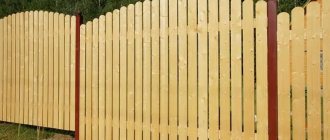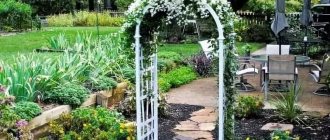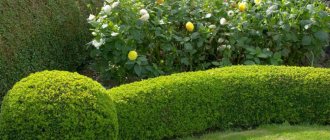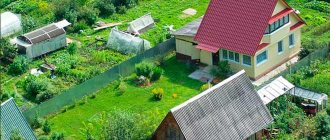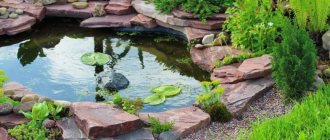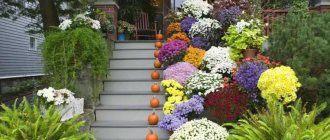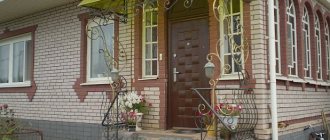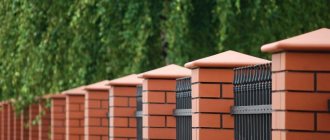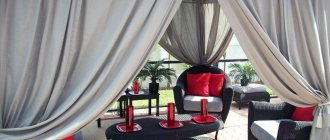Review author: Terrari School of Design
You can landscape and improve the territory of your site by installing an unusual fence. The main thing is that the fence is in harmony with the landscape of the site. The fence performs a number of functions. The fence can be installed not only along the external boundaries of the site, but also inside the territory. For example, a delimiter of territory into sections or to fence off flower areas. It is quite possible to create an exquisite, as in the photo, decorative fence yourself and even from existing materials.
Before choosing what raw materials to make from and what the structure will look like, you need to decide what function the fence will perform. Will it just be a decorative element or protection from unwanted neighbors' eyes, or maybe it will serve as a fencing for certain areas of the site.
What to make a fence from
A natural and popular material for fencing is wood. There are several types of wooden fences:
- picket is evenly spaced wooden planks;
- lattice fence. This design is a frame with slats attached to it. Can be used both for external fencing and inside the site;
- a palisade is a fence made of logs or branches of varying heights, pointed upward.
The main disadvantage of a wooden fence is that even the most thorough impregnation of it with special means does not prevent the wood from rotting where it comes into contact with the ground.
Plant raw materials for collection:
- wattle fence, a fence made from hazel, willow or willow branches. Suitable for all types of fences;
- bamboo is light but durable. Used in gardens decorated in oriental style. Bamboo can last up to twenty years if properly treated;
- branches and snags collected in the forest or cut down from trees on the site serve as an excellent material for a fence that will add a natural touch to the design of the site.
Forged and welded fences look aesthetically pleasing, but are an expensive option. They are divided into two categories: standard and exclusive, made to order.
Long-lasting metal fences look great in any landscape design style. Stone fences give the site a natural look.
A fence made from natural stone such as sandstone or slate is an expensive proposition. The stones are fastened together with a concrete solution or laid on top of each other without concrete.
An original fence can be made using pebbles or paving stones as a basis, as well as fragments of tiles, especially in combination with glass elements. Brick is most often used to fence paths or flower beds. A metal mesh (gabion) filled with stones is suitable for strengthening river banks or landslide areas.
Lately, decorative concrete fences have become very popular. There are concrete segments, blocks of various shapes and configurations: smooth or stylized to resemble natural stone.
Decorative fences made of durable plastic of various colors come in strip and sectional types. Commonly used if necessary:
- divide the area into zones,
- fence flower beds and flower beds,
- separate the playground area,
- make garden paths. The advantages of such fences include: light weight, ease of installation, durability, variety, and ease of operation.
Fences in the form of a lattice with stones - “German fences”
A very reliable option is to create a fence using a metal structure filled with stone. Such models are called “German” fences. These are stylish modern fences that are distinguished not only by their impressive appearance, but also by their ease of installation. If you buy ready-made elements of a metal frame, you don’t have to resort to the services of blacksmiths. The stones that fill the interior space can have different shapes, sizes and colors.
For installation, you will need to create a concrete foundation. In this case, you can either use the pit method of placement (that is, concrete only those places where the pillars will be located), or fill a trench throughout the entire territory of the fence. The pillars are located at equal distances from each other, and fence sections are installed between them. It is most convenient to use square-shaped pipes. However, they can have any design based on the site design project.
Gabion fences are becoming increasingly popular due to their ease of installation and operation.
It is recommended to use a metal rod for sections. It provides significant reliability and has an attractive appearance. In this case, the rod can be bent in different ways, giving it an original appearance. Of course, forging elements will affect the price of a German fence. However, this type of design is attractive both in its simple design and in more intricate design solutions.
Available materials for the fence
Old trash can be very necessary and useful if you use your imagination and take a creative approach to designing fences. In addition, creating a fence from what you have on hand will significantly save your budget.
Bottles made from any raw material, buried with the neck down, can become a unique fence for any flower garden.
From car tires, cut or painted, you can make a fence in two or three tiers.
Vinyl discs, old ceramic plates and other household items can be safely used as raw materials for building a fence.
If there is unnecessary slate on the site, you can use it as a building material for a fence, strengthening it with wood or reinforcement.
Fence for flower beds
It happens that scraps of corrugated sheeting that remain from the construction of the main fence or roof are used as a fence material for a flower bed. The pieces are driven into the ground around the flower bed. This type of fencing is very durable.
In principle, for small fences you can use any available material. The main thing is that the existing material fits harmoniously into the overall design of the site.
"Store" options
If the budget allows, then available materials can be replaced with purchased ones. Thus, construction and garden supply stores sell various decorative fencing, which can easily be assembled on site yourself.
Fence made of plastic elements
Pros:
- availability of ready-made parts and ease of installation;
- the ability to build fences both on a flat surface and on a site with a slope;
- flexibility of elements, variety of shapes, colors and the ability to imitate any natural material (stone, wood, brick);
- light weight, allowing you to easily carry parts around the site.
Minuses:
- it is impossible to manufacture individual elements yourself, so everything will have to be purchased at the store;
- if some parts are damaged, they will also need to be replaced with custom ones in order to maintain the unity of the design;
- poor frost resistance - at low temperatures the plastic is destroyed, but this can be avoided by removing the decorative fencing in the shed for the winter until spring.
Plastic fence is very cheap and easy to install
Fence made of polymer products
These are polycarbonate sheets attached to a metal frame.
Pros:
- aesthetic appearance;
- variety of sizes and colors;
- high quality material.
Minuses:
- high cost.
Polycarbonate fencing looks very aesthetically pleasing
Concrete fence
Decorative concrete fencing is very popular today and fits any style in which the house and outbuildings on the site are decorated.
Pros:
- durability, strength;
- variety of shapes, types of products;
- Possibility of painting in any color, decoration in any style.
Minuses:
- high price.
A concrete fence is very durable, but also expensive
DIY fence
One of the easiest ways to make a fence with your own hands is to make it from cut tree branches and twigs. Thick branches will serve as supporting posts, and thin branches are suitable for weaving.
Install the side pegs in the ground, having previously treated the part that is in the ground with resin. Attach transverse branches to them. The rods for weaving must be the same size and bend around the transverse branches with alternation.
A small picket fence is very easy to make. To do this, you need to lay transverse strips on the ground and attach a picket fence to them.
The palisade must be sanded and varnished, and left in the fresh air to dry. Make markings on the ground for driving in the palisade boards. Drive the palisade into the ground and level it in height.
It is advisable to treat fences made of wooden materials with an antiseptic or varnish them to protect them from rot and pests.
Gabion fence
If you want to have a durable and original fence design, pay attention to gabion fencing. Such a fence will not require any maintenance at all. This is an excellent alternative to expensive analogues made from natural stones. The installation process is much easier because there is no need to build a foundation. It is enough to simply concrete the pillars, which will become the basis for fastening the mesh.
Fence using gabions
The stones are placed in a mesh frame. Grid cells can be small or large. The beauty of the fence will depend on the fraction of stones filling it. Small components do not look very advantageous, but this is a matter of everyone’s taste. It happens that gabions are generally filled with simple crushed stone. To give your fence originality, you can use stones of other types in your work. Colored cobblestones will help create an ornament. And further. It is not at all necessary to make such a fence the same type. It will look more interesting in combination with other subspecies of its fellows.
When making gabions, you can combine various materials
Interesting ideas
Decorative fence posts are made from various materials: wood, stone, concrete, plastic. They are used to achieve additional strength of the fence and protection from natural phenomena.
To make a mesh or lattice fence look more original, you can use vertical landscaping. Plants and shrubs such as hedges can be used as fencing material.
Fence materials can be combined to create unique compositions. For example, build a wooden picket fence into a brick fence or cover a wooden fence with iron.
